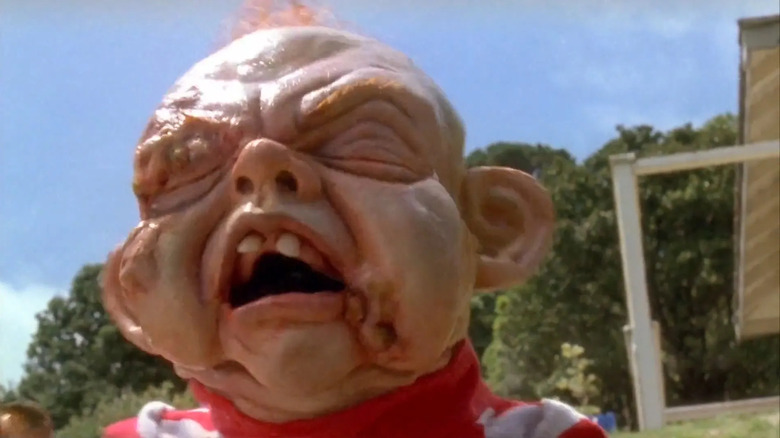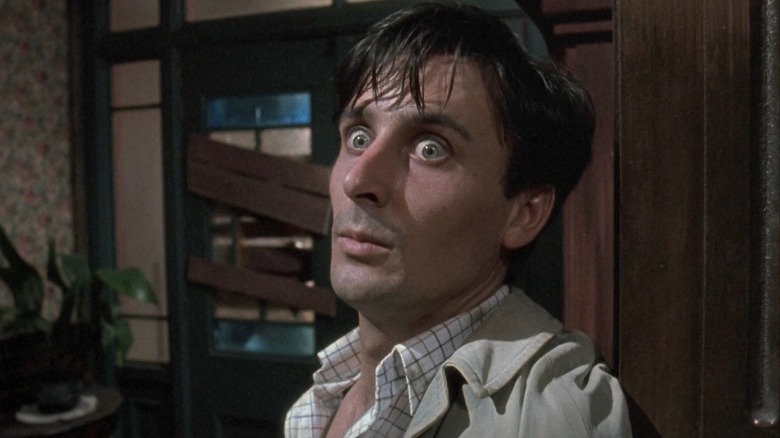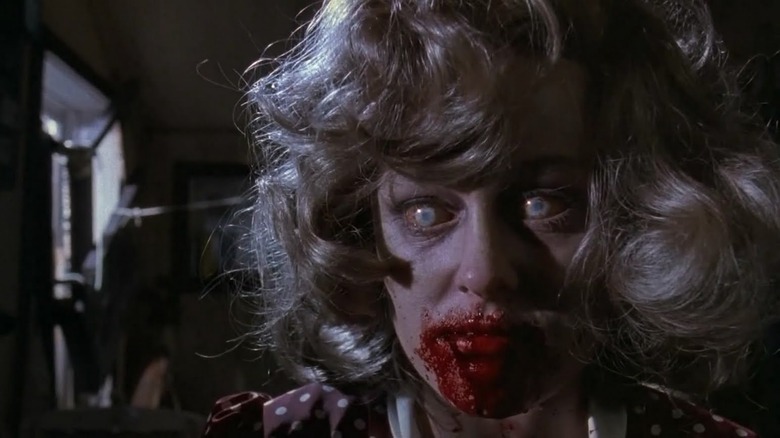Peter Jackson Wanted Dead Alive To Be A Splatter Film That Non-Horror Fans Could Love
Peter Jackson's 1992 film "Braindead," released in North America as "Dead Alive," while certainly an object of intimidation for gore-averse cineastes, remains, at its heart, a comedy film. Jackson has spoken in the past about how "Dead Alive" was not inspired so much by raw, hard-edged gore films like "Cannibal Holocaust," and more by the whimsical violence of "Monty Python and the Holy Grail." A notable scene in the 1974 comedy classic features a bridge sentry, the Black Knight (John Cleese), getting into a swordfight with King Arthur (Graham Chapman). Over the course of the fight, his extremities are sliced off one by one, only to return to battle unfazed. While blood spurts copiously from each severed limb, the Black Knight doesn't seem to feel any pain.
When he is reduced to a mere head and torso, only then will he admit that his swordfight will now have to be declared a draw. The fact that he never screams in agony might be the crux of the scene's comedic power. It's not necessarily the violence that's funny, but the Black Knight's misguided tenacity in its face. The fact that the violence is extreme — those wounds really gush! — underlines the unreality of the scene.
A similar thought might be applied to Jackson's film. While human characters do scream and wail when they are mutilated by zombies, the zombies themselves do not. When a zombie loses a limb or a portion of its head in "Dead Alive," they seem a little miffed, maybe even confused. The curse is taken off.
Cheap laughs > true horror
When a human has all the flesh gnawed off his legs, one can chortle heartily at his plight. This, Jackson is saying, is not meant to frighten you. It may shock you, but ultimately it exists to make you laugh. Like Sam Raimi's "Evil Dead 2: Dead by Dawn" before it, "Dead Alive" uses the iconography of horror, but the language and timing of comedy. One might even be forgiven for placing the two respective VHS cassettes in the "comedy" section of your local video store.
In a 1992 interview with Film Threat Magazine, Jackson laid out his filmmaking ethos clearly: a "low" splat-stick gag is always going to take precedence over any notions of genuine fear. Jackson can be fitfully scary, but a look over his horror films ("Bad Taste," "Dead Alive," "The Frighteners"), as well as his utterly disgusting backstage showbiz puppet drama "Meet the Feebles," reveals a definite comedic undercurrent. Throughout his early work, one would go into a Jackson film expecting to recoil and giggle in equal measure.
The darker, so-called "hardcore" horror films might have interested Jackson as a viewer, but not so much as a filmmaker. As he explains:
"[L]ike 'Bad Taste,' ['Dead Alive' is] a splatter film that non splatter fans can go see. The humor dilutes the gore to a point that is acceptable, but still there for the fans. On the other hand, I'm not interested in making 'hardcore' horror films, like a 'Henry: Portrait of a Serial Killer' or even 'Texas Chain Saw Massacre,' although I enjoy both those films. I like comedy too much, to the point that I could never make a film that took itself that seriously. Fundamentally, I just want to entertain people, so I usually trade in cheap laughs for true horror."
The evolution of a gorehound
After "Dead Alive," Jackson moved on to the 1994 biographical queer crime drama "Heavenly Creatures," starring Melanie Lynskey and Kate Winslet. It's his most grounded film. While still energetic and dynamic, "Heavenly Creatures" is remarkably light on special effects, an oddity for a filmmaker who would become increasingly interested in the technical side of filmmaking as time passed.
After the hilarious cinema mockumentary "Forgotten Silver" — wherein Jackson, a Kiwi himself, posits that a fictional 1910s New Zealand filmmaker named Colin McKenzie was the true pioneer of all cinema — the director took a hard turn into CGI, making the effects-heavy "The Frighteners" in 1996 and a series of six slick, glittering fantasy pictures from 2001 to 2003, and 2012 to 2014. In between, he tinkered with what film special effects could do with an intentionally bloated remake of the 1933 film "King Kong" and the unusual afterlife dud "The Lovely Bones." His last two films have been documentaries that experimented with colorization, shifting frame rates, and visual fidelity.
In 1992, Jackson seemed keen on making audiences laugh. Around 2001, he shifted to po-faced earnestness and has been there ever since. Jackson's next film has not yet been announced, but one might say with confidence it won't be an irreverent splatter film.
Luckily, if one has a strong enough constitution, "Dead Alive" awaits. It's not currently on any streaming service and perhaps is better for being so rare. If you want to watch a living bowel strangle someone, you're going to have to hunt.


